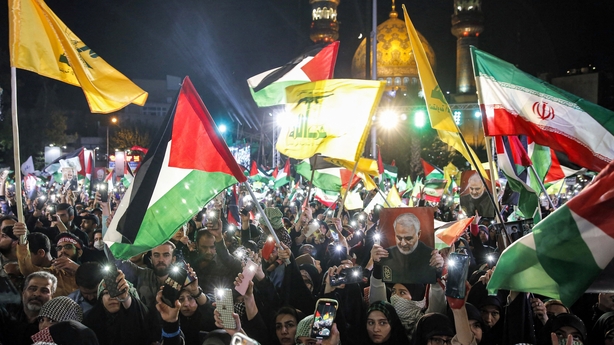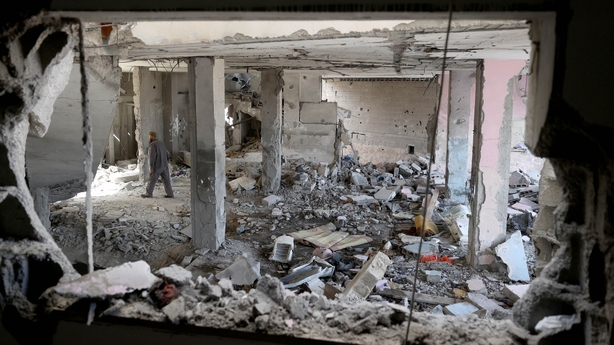Beyond Gaza, tension has been growing in the Middle East in recent days with air strikes in Syria, bombs falling in Lebanon and violence erupting in the West Bank.
Here are some of the key developments.
Syrian Airports
On Sunday, Israel bombed the airports in the Syrian cities of Damascus and Aleppo.
Syrian state media said two workers at Damascus airport were killed in the strikes.
The Israeli government has hit targets in Syria over recent years but Sunday's strikes on the airports were the third in 10 days.
Typically, the Israeli government and military do not comment on such strikes.
However, in response to suggestions from analysts that Israel is bombing the Syrian airports as part of an attempt to pre-empt efforts by Iran to transport weaponry to Hezbollah in Southern Lebanon, a senior official from the Israel foreign ministry tweeted "we are."
Iranian-backed armed groups have developed a major presence in Syria in recent years and played a key role in bolstering Syrian ruler Bashar Al-Assad's attempts to remain in power in the face of war and revolution.
Israel-Lebanon border
On Sunday, the Israeli military published several updates in which it said it had targeted Hezbollah fighters in southern Lebanon who were preparing or attempting to launch missile attacks on northern Israel.
The Israeli authorities also issued evacuation notices to people in 14 more communities, roughly two kilometres from the Lebanon border, bringing to 42 the number of towns and villages from which people have been asked to leave since 7 October.
Some 26 Hezbollah fighters and at least five Israeli soldiers have been killed since, in what the Reuters News Agency has called "the deadliest escalation of frontier violence since an Israel-Hezbollah war in 2006."
The rocket fire and strikes have been occurring in various locations along the 120km Israel-Lebanon ceasefire line – known as the Blue Line - including in the area patrolled from Camp Shamrock, where Irish United Nations peacekeepers are based.
Like Hamas, Hezbollah, is backed by Iran and considered a terrorist organisation by the US, the UK, and others. While Hamas is Sunni Muslim group, Hezbollah supporters practice Shia Islam, the same type practiced in Iran.

Hezbollah exerts significant social and security control within Lebanon and is often referred to as a 'state within a state'.
Its members are ministers within the Lebanese government and it controls a vast arsenal of weapons, rockets, and battle-hardened fighters. It has hit various military outposts and infrastructural elements along the blue line.
Analysts say it is projecting the threat of a second military front to Israel, as Israel says it plans to enter Gaza to attack Hezbollah’s ally, Hamas.
On Saturday, at the funeral of a Hezbollah fighter, the deputy leader of Hezbollah reportedly said to a gathered crowd: "Do you believe that if you try to crush the Palestinian resistance, other resistance fighters in the region will not act?"
West Bank tension
While the Israeli military regularly raids Palestinian-controlled areas of the West Bank, it rarely uses air strikes. However, on Sunday, it bombed a mosque in Jenin, saying it was being used by Hamas and the Palestinian Islamic Jihad group.
"Intel was recently received which indicated that the terrorists who were neutralised were organising an imminent terror attack," a statement from the Israeli military said.
At least one person was killed and three injured.
The West Bank is recognised internationally as Palestinian territory, but 60% is controlled and occupied by Israel, with Palestinian movement between areas severely restricted by the military and other Israeli authorities.
The Palestinian-controlled areas of the West Bank are governed by the Palestinian Authority, controlled by the Fatah organisation, but Hamas also operate there.
Since 7 October, tensions between Israelis and Palestinians in the West Bank have increased. More 90 Palestinians have been killed, the Palestinian health ministry said on Sunday. Hundreds have been detained during clashes and raids by the Israeli security services.
The spike in tension comes on top of an already bad year for the West Bank. Violence between Israeli settlers and Palestinians reached its worst level in years in the first six months of 2023, with many observers saying Israeli settlers have been emboldened by statements from hardliners in Israel's new right-wing government.
The situation was further inflamed by the Hamas attacks of 7 October and the blast at Al-Ahli Hospital in Gaza on 17 October, which was widely attributed to Israel by leaders and media across the Arabic-speaking world - and triggered protests across the region. Israel denied responsibility and said the cause of the explosion was a failed rocket launch from Gaza.
Read more: What is known about the blast at the hospital in Gaza?

US carrier intercepts missiles from Yemen
The escalations over the weekend follow a statement on Thursday from the US, in which it said a Navy warship in the Red Sea shot down several cruise missiles and about a dozen drones launched by the Iranian-backed Houthi group in Yemen.
"We cannot say for certain what these missiles and drones were targeting, but they were launched from Yemen heading north along the Red Sea, potentially towards targets in Israel," Pentagon spokesperson Brigadier General Patrick Ryder said.
The flight path from Yemen to Israel is across Saudi Arabian airspace. Saudi Arabia is involved in the ongoing civil war in Yemen; it backs government forces and opposes the aims of Houthi rebels there. The Houthis practice a form of Islam like the Shia Islam practiced in Iran.
We need your consent to load this Datawrapper contentWe use Datawrapper to manage extra content that can set cookies on your device and collect data about your activity. Please review their details and accept them to load the content.Manage Preferences
The United States has sent a significant amount of naval power to the Middle East in recent weeks, including two aircraft carriers, their support ships and about 2,000 Marines.
On October 12, US President Joe Biden said part of the rationale for the deployment of such forces was to support Israel, and that the US "made it clear to the Iranians: Be careful."







